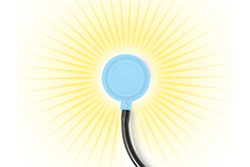A Ray of Hope


By Dr. Sarathi Kalra
Stethoscopes are an integral part of acute and clinic patient care settings. In addition to routine physical exams, various medical conditions require thorough auscultation of the chest and abdomen for a comprehensive evaluation.
While some may argue that advancements in ultrasound and CT imaging provide superior clinical information, it is inappropriate to over-test patients, even when adequate healthcare resources are available. Additionally, due to financial feasibility and potential health risks from radiation exposure, it is not practical for the majority of hospitals to unnecessarily image all patients as radiation poses health risks. As such, the stethoscope has been, and will continue to be, an essential tool in patient care decision-making.

In acute care settings, the stethoscope is the “gateway” to choosing the appropriate imaging or procedure for a patient who is having difficulty breathing. Similarly, a child presenting with a detected heart murmur may prompt additional imaging, such as an echocardiograph. Without a stethoscope, there is the potential for significant delay in the identification of medical conditions. Over the last several decades, it has become evident that stethoscopes are vectors of infection. Several studies have shown that bacteria with the potential to cause fatal infections can be grown from different parts of the stethoscope.1-3
Assuring an aseptic barrier is available to protect every patient is long overdue development - the AseptiScope™ DiskCover™ System provides an evidence-based “ray of hope.” Studies show the DiskCover aseptic barriers are effective in preventing patient exposure to harmful pathogens and contaminants while preserving sound quality for an optimal clinical experience.4,5 Furthermore, it is easy to apply and remove new barriers, in seconds, between every patient exam.
As an Emergency Medicine physician who was recently diagnosed with COVID-19, I know any available barrier that may prevent infection transmission from clinician to patient is of utmost importance. SARS-CoV-2 has been detected on various hospital surfaces, including the stethoscope.6
For stethoscope infection barriers, the system must be easy to apply, aseptic and not impede the quality of auscultation. With the supportive evidence from clinical studies, the AseptiScope DiskCover System demonstrates these critical attributes and provides valuable protection to benefit patients and health care providers alike. Prevention is always better than cure, and the DiskCover System is a fast and simple solution that helps keep patients safe without impacting provider care.
1. Longtin Y, et al. Contamination of stethoscopes and physicians' hands after a physical examination. Mayo Clin Proc. 2014;89(3):291-299.
2. O’Flaherty, N.; Fenelon, L. The stethoscope and healthcare-associated infection: A snake in the grass or innocent bystander? J. Hosp. Infect. 2015, 91, 1–7.
3. Raghubanshi, BR, et al. Use of 90% ethanol to decontaminate stethoscopes in resource limited settings. Antimicrob. Resist. Infect. Control 2017, 6, 68.
4. Vasudevan R, et al. Aseptic Barriers Allow a Clean Contact for Contaminated Stethoscope Diaphragms. Mayo Clin Proc Innov Qual Outcomes. 2020;4(1):21-30. Published 2020 Feb 5.
5. Data on file, AseptiScope.
6. Pasquarella C, et al. Detection of SARS-CoV-2 on hospital surfaces. Acta Biomed 2020; Vol. 91, Supplement 9: 76-78.

Dr. Sarathi Kalra is an Assistant Professor and Research Director for the Department of Emergency Medicine at University of South Alabama in Mobile, AL. He has been closely involved with the department leadership in building the residency program and research curriculum for emergency medicine residents.
Third Hand Vector series spotlights the clinician’s third hand and the risks that contaminated stethoscopes pose to clinicians, patients and healthcare systems. The series features leading experts in infection control, patient care and quality measures raising awareness of the importance of aseptic barriers in reducing transmission of infectious diseases.
